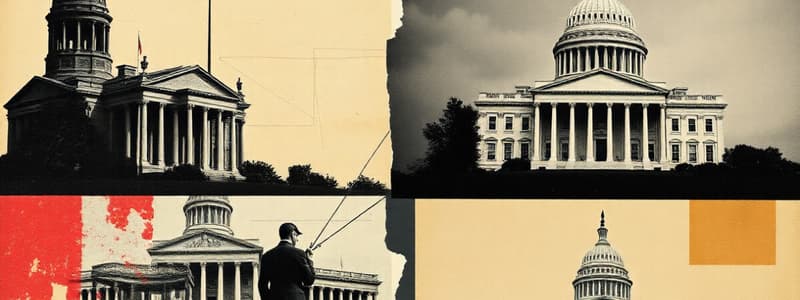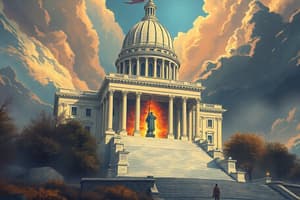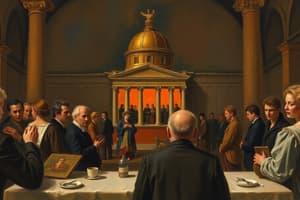Podcast
Questions and Answers
Explain how the concept of popular sovereignty influenced the creation of the American republic.
Explain how the concept of popular sovereignty influenced the creation of the American republic.
Popular sovereignty, the idea that people are the highest authority, influenced the American republic by establishing a government where power is held by the people who elect representatives. These representatives manage the government for the common good.
How does federalism, as established by the Constitution, address concerns raised by Anti-Federalists regarding centralized power?
How does federalism, as established by the Constitution, address concerns raised by Anti-Federalists regarding centralized power?
Federalism divides power between the national and state governments, addressing Anti-Federalist concerns about centralized power by ensuring states retain significant autonomy and preventing the national government from becoming too dominant.
Describe how the principle of separation of powers directly limits the potential for legislative supremacy in the U.S. government.
Describe how the principle of separation of powers directly limits the potential for legislative supremacy in the U.S. government.
Separation of powers divides governmental authority among the legislative, executive, and judicial branches, preventing any single branch from becoming too powerful and thus directly limiting the potential for legislative supremacy.
Explain how the inclusion of a Bill of Rights in the Constitution addressed the concerns of those who feared the power of the central government.
Explain how the inclusion of a Bill of Rights in the Constitution addressed the concerns of those who feared the power of the central government.
Describe how the system of checks and balances prevents the executive branch from becoming too powerful.
Describe how the system of checks and balances prevents the executive branch from becoming too powerful.
How does the structure of a bicameral legislature contribute to more careful and deliberate lawmaking compared to a unicameral system?
How does the structure of a bicameral legislature contribute to more careful and deliberate lawmaking compared to a unicameral system?
Explain how the power of judicial review, vested in the Supreme Court, impacts the laws passed by the legislative branch.
Explain how the power of judicial review, vested in the Supreme Court, impacts the laws passed by the legislative branch.
In what ways does the concept of limited government relate to the protection of individual liberties as outlined in the Constitution?
In what ways does the concept of limited government relate to the protection of individual liberties as outlined in the Constitution?
Flashcards
Confederation
Confederation
A nonbinding political alliance of independent countries, states, or groups.
Bicameral
Bicameral
A political system based on two legislative chambers or houses.
Constitution
Constitution
A basic set of principles and laws of a nation, state, or social group that determine the powers and duties of a government and guarantee certain rights to its people
Popular Sovereignty
Popular Sovereignty
Signup and view all the flashcards
Jurisdiction
Jurisdiction
Signup and view all the flashcards
Amendment
Amendment
Signup and view all the flashcards
Checks and Balances
Checks and Balances
Signup and view all the flashcards
Limited Government
Limited Government
Signup and view all the flashcards
Study Notes
- Confederation constitutes a nonbinding political alliance of independent countries, states, or groups.
- Bicameral refers to a political system based on two legislative chambers.
- Unicameral is a legislature consisting of a single chamber.
- Veto is the action by which an executive rejects a bill submitted by the legislature, effectively refusing to approve it.
- Constitution embodies the basic principles and laws of a nation, state, or social group that determine the powers and duties of a government and guarantees certain rights to its people.
- Popular sovereignty means the people are the paramount authority within a government.
- Legislative supremacy describes a system of government where most of the power is given to the legislature.
- Republic describes a nation with a government in which power is held by the people who elect representatives to manage the government for them for the common good.
- Common good means the good of the community as a whole.
- Jurisdiction is the power or authority to hear cases and make decisions.
- Tariff refers to a tax on imported or exported goods or a list or system that describes such taxes.
- Amendment signifies a change or addition to a document or plan, such as the Constitution.
- Bill of Rights comprises the first 10 amendments to the Constitution.
- Checks and balances are a system in which the power of each branch of government is balanced and checked by the powers of the other branches.
- Federalism describes a system of government in which power is shared between the central (national) government and the state governments.
- Founding Fathers were the writers and framers of the Constitution and also known as the founders.
- Ratify means to approve and make official.
- Judicial branch is the part of the government that interprets the laws through its decisions in legal cases.
- Preamble is the introductory part of the Constitution.
- Supreme Court is the highest level of the judicial branch of the federal government and the highest court in the country; there are also state supreme courts.
- Anti-Federalist was an opponent of the central government as defined by the Constitution and against its ratification.
- Federalist was a supporter of ratification of the Constitution.
- Limited government represents a system restricted to protecting natural rights that does not interfere with other aspects of life.
- Separation of powers involves the division of powers among the different branches of government.
- Legislative branch is the law-making part of government.
- Executive branch constitutes the part of government headed in the United States by a president or governor, that carries out the laws.
Studying That Suits You
Use AI to generate personalized quizzes and flashcards to suit your learning preferences.
Description
Explore key governmental concepts such as confederation, bicameralism, unicameralism, and veto power. Understand fundamental principles including constitutions, popular sovereignty, and legislative supremacy. Learn about republics, the common good, and jurisdictional authority.




